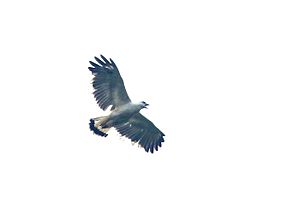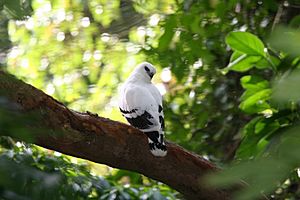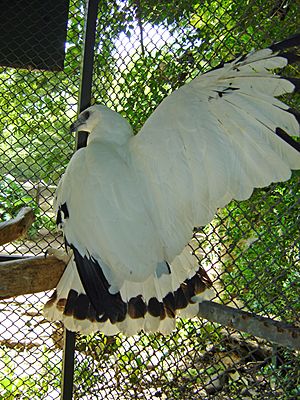White hawk facts for kids
Quick facts for kids White hawk |
|
|---|---|
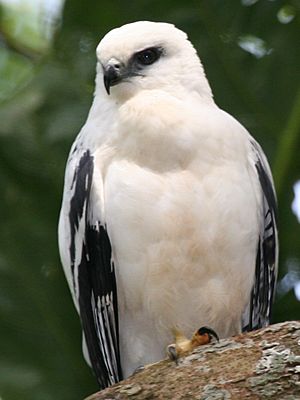 |
|
| Conservation status | |
| Scientific classification | |
| Genus: |
Pseudastur
|
| Species: |
albicollis
|
| Subspecies | |
|
|
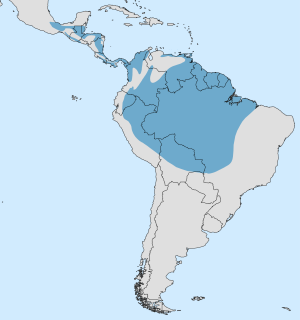 |
|
| Synonyms | |
|
Leucopternis albicollis |
|
The white hawk (scientific name: Pseudastur albicollis) is a beautiful bird of prey. These birds live in the warm, tropical parts of the Americas. They belong to the Accipitridae family, which includes many hawks, eagles, and kites.
Contents
About the White Hawk
Adult white hawks are about 46 to 56 centimeters (18 to 22 inches) long. They have very wide wings, which help them soar high in the sky. Their head, body, and the underside of their wings are bright white.
The top of their wings is black. Their short tail is also black with a wide white band across it. They have a black beak and yellow legs.
Male and female white hawks look very similar. However, females are usually bigger and heavier. A female might weigh about 840 grams (1.85 pounds), while a male weighs around 650 grams (1.43 pounds).
Young white hawks look a bit different. They have many black spots on their upper body. Their white undersides also have dark streaks.
The sound a white hawk makes is a sad-sounding call. It sounds like "kerwee."
White Hawk Subspecies
There are four main types, or subspecies, of the white hawk. They each have slightly different features and live in different areas:
- Pseudastur albicollis ghiesbreghti – This subspecies lives from southern Mexico down to Nicaragua. It is almost completely white, except for black marks on the outer wing feathers. It also has a black bar near the end of its tail. These hawks have yellow eyes.
- Pseudastur albicollis costaricensis – You can find this one from Honduras to Panama and Colombia. It looks a lot like the ghiesbreghti subspecies. However, it has clearer black marks on its wings and tail. This subspecies has brown eyes.
- Pseudastur albicollis williaminae – This hawk lives in certain parts of northwestern Colombia and western Venezuela. Its wing feathers have more black marks. It also has black streaks on its head and neck. The black band on its tail is wider, and it has brown eyes.
- Pseudastur albicollis albicollis – This subspecies is found from northern Colombia and central Venezuela all the way to Brazil. It is smaller than the other types found further north. Its wings are mostly black with some white marks. The black tail band goes all the way to the base of the tail. This hawk also has brown eyes.
No matter the subspecies, all white hawks look mostly white when seen from below.
How Scientists Study White Hawks
Scientists give every animal a special scientific name. This helps everyone around the world know exactly which animal they are talking about. The white hawk was first described by a scientist named John Latham in the late 1700s. He first called it the "white-necked falcon."
Over time, scientists learn more about animals. They sometimes change how they group them. For a long time, the white hawk was placed in a group called Leucopternis. But in the early 2000s, scientists used DNA to study these birds. They found that the white hawk and its close relatives were different enough to be put into their own group. So, they brought back an older name, Pseudastur, for the white hawk.
This kind of study helps scientists understand how different species are related to each other.
Where White Hawks Live and What They Eat
The white hawk lives in lowland forests and other wooded areas. Its home stretches from southern Mexico through Central and South America all the way to Peru, Bolivia, and Brazil. You can also find them on the island of Trinidad. They are quite widespread, especially across the entire Amazon basin.
Even though they live in a large area, white hawks are not usually seen everywhere. However, because their range is so big, scientists believe they are not currently in danger of disappearing.
White Hawk Diet
White hawks are skilled hunters. They mostly eat reptiles, like lizards and snakes. They have even been seen eating dangerous snakes like the eastern coral snake.
Besides reptiles, their diet also includes:
- Insects, such as beetles and grasshoppers
- Crabs
- Amphibians
- Small mammals, including rats, squirrels, small opossums, and even bats
They catch their prey by swooping down from a high perch. White hawks have also been known to eat other birds, like keel-billed toucans and mottled owls. They might go after young or weak birds. Very rarely, they might even eat fish.
Sometimes, white hawks follow groups of tufted capuchin monkeys or South American coatis. These animals stir up insects and small creatures as they move, making it easier for the hawk to catch a meal.
Reproduction and Life Cycle
White hawks build large nests made of sticks high up in trees. The female usually lays one egg, which is blue-white with dark spots. They often perform amazing aerial displays during courtship, soaring and diving in the sky.
See also
 In Spanish: Busardo blanco para niños
In Spanish: Busardo blanco para niños



